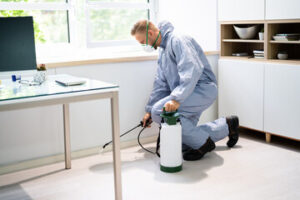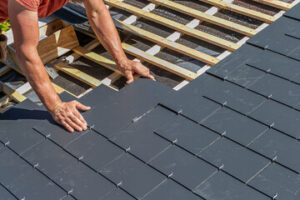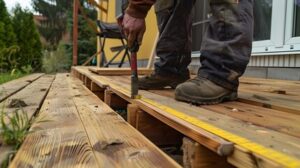When Henry Ford’s horseless carriages hit the market in the early 1900s, owners needed someplace to store their cars other than a house with smelly horses. The garage was born.
Garage doors are available in a range of materials. Choose the one that best fits your climate, budget, maintenance preferences, and energy efficiency goals. Click https://patriotgaragedoorok.com/ to learn more.

While many burglaries take place in a home’s living space, a significant number of criminals gain access through the garage. Making garage security a priority helps prevent this, and it can even help lower homeowner insurance rates by reducing the risk of theft.
Several features of your garage door can make it more difficult for intruders to break in. One is to choose a garage door with thick, sturdy materials, such as double-skinned metal panels and a strong steel frame. Another option is to get a side-hinged garage door instead of an overhead model, which adds extra strength and durability to the design.
Another way to enhance your garage door’s security is to install motion sensors. These can detect any movements around the doors, and they can also warn you of a breach in your garage’s security by sending a smartphone alert to your mobile device. This technology makes it possible to monitor your garage, especially when you’re away from the house, without having to return there to check on things.
Some modern garage openers also come with rolling code technology. This is an important upgrade from conventional fixed codes, as it renders them useless to hackers because the encryption constantly changes. This can significantly decrease your risk of break-ins through the garage and other areas of the home.
Finally, a simple deterrent to thieves is to use frosted windows on your garage door. This adds a nice aesthetic, while keeping out prying eyes of people walking by on the street. It can also help reduce energy costs by letting in natural light while preventing unwanted intruders from peering inside.
Many homeowners forget to close their garage doors completely when they leave the house, which gives burglars an open invitation to steal anything they can see through the window. A good solution is to connect your garage door to your home security system, enabling you to control it with the touch of a button on your smartphone or tablet. Some systems, such as Liftmaster’s MyQ technology, also include an alarm feature that lets you know if the doors are opened or closed.
Energy Efficiency
With energy costs on the rise, many homeowners are looking for ways to lower their utility bills. One often overlooked option is an insulated garage door. In fact, an insulated garage door can save you up to 10% on annual heating and cooling expenses. The key is to ensure your garage door has sufficient insulation and a tight seal. This prevents warm air from escaping during the summer and cold air from entering in the winter, resulting in more efficient energy usage.
The primary factors that determine how well a garage door is insulated are its R-value and U-factor. The R-value is a measure of the resistance to heat flow, with higher values indicating better insulation properties. The U-factor, which is the inverse of R-value, measures how much heat actually passes through a material. A higher U-factor means more heat will pass through the door, while a lower one indicates greater efficiency.
Energy efficiency is especially important when your garage is attached to your living space. Fluctuating garage temperatures can affect the temperature in your home, forcing HVAC systems to work harder to maintain a consistent indoor climate. A properly insulated garage door prevents this from happening, resulting in reduced energy consumption and improved comfort.
In addition to lowering your energy costs, an insulated garage door also adds value to your home and increases its resale potential. When compared to the cost of a non-insulated garage door, an energy efficient option can pay for itself in a few years.
The most effective energy-efficient garage doors feature double or triple layers of insulation, with high-density polyurethane being the preferred choice. These doors are ideal for regions that experience extreme weather conditions, as they offer superior thermal resistance and insulation. The combination of steel and polyurethane helps them withstand impacts and other damaging elements, ensuring they will last longer than other types of garage doors. Depending on the manufacturer, these doors may also be coated with a paint that resists rust and corrosion, further increasing their durability and energy efficiency.
Design
A garage door is a prominent feature of any home, and its aesthetic influences the overall look of your property. Choosing the right design features ensures that your garage door complements your home’s architectural style and enhances its curb appeal.
Decorative elements, such as windows and handles, can add visual interest to your garage door. Window options, including opaque, frosted or tinted glass, help reduce heat gain and light exposure while maintaining privacy. You can also choose a panel material and frame color to match or contrast your home’s exterior trim for a cohesive look or to create a bold statement.
When it comes to the construction of your garage door, panel size and thickness play an important role. Thicker panels offer greater durability and are more resistant to environmental damage, as well as dents from wayward footballs or basketballs. A garage door with insulated panels can help regulate the temperature of your space and save on energy bills.
Traditional raised-panel garage doors are crafted from various materials and can complement different architectural styles. Wood composite garage doors, for example, offer a timeless appearance while resisting moisture and avoiding warping, splitting or rot. They also come in a variety of paint or stain colors and can be customized with decorative hardware. A range of window options further enhances their versatility, from full-length, horizontal edges to short rectangular windows.
Contemporary garage doors are characterized by clean lines and geometric shapes, and they often incorporate unique design details. For example, some garage doors are curved and include a retractable section that opens like a bi-fold closet door. These doors are a perfect complement to minimalist home designs.
The latest technology in garage doors includes integrated security measures that deter criminals and alert homeowners to potential threats. These measures can include biometric access control, smart cameras and advanced alarm systems. Some even have a manual release handle, allowing homeowners to open their garage door in the event of an electric outage or opener malfunction.
Maintenance
Your garage door operates several times a day, and its components are exposed to wear and tear. A proactive approach to maintenance can prevent potential damage and extend its lifespan. A good starting point is inspecting the hardware for loose bolts and screws, which can be tightened with a wrench or screwdriver. Also, a regular lubrication schedule can help components last longer and operate more smoothly. Lubricants are available in a variety of forms and can be used to reduce friction between metal parts, such as hinges or roller bearings. Silicone-based sprays are ideal for metal-to-metal applications and offer a long-lasting film. Lithium-based grease is useful for reducing friction between moving parts in belt and chain drive systems.
Keeping your garage door in top condition will not only save energy, but it can also enhance the appearance and comfort of your home’s interior. For instance, repairing or replacing weatherstripping that has become worn can create a tight seal to reduce heat loss and air infiltration. Additionally, a well-functioning door will keep out rain and pests.
Modern doors prioritize safety with built-in features such as photo-eye sensors and auto-reverse mechanisms. These safeguards are essential to ensure the garage door does not close on anything or anyone, and regular testing is recommended. A simple test involves placing an object, such as a roll of paper towels, in the path of a closing door to confirm it reverses immediately upon contact.
Additionally, regularly checking the garage door’s springs and cables is essential. A broken cable can result in a sudden collapse of the entire system, which can be dangerous and costly. Using extreme caution, you can visually examine the cables and pulleys for signs of rust or excessive wear and call a professional to replace them. Also, the end bearing plates at each side of the spring bar should be inspected for rust or damage. Since they are under a significant amount of tension, this is a task best left to a professional. Similarly, the garage door’s track should be inspected for dents or rust and carefully cleaned to maintain smooth movement.








